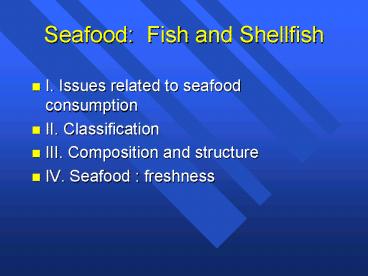Seafood: Fish and Shellfish - PowerPoint PPT Presentation
1 / 42
Title:
Seafood: Fish and Shellfish
Description:
Seafood Utilization: Sashimi quality tuna. Fresh eel. Live Fish Market: Tsukiji. Live Fish ... Why is fish meat white and why does it flake? ... – PowerPoint PPT presentation
Number of Views:3928
Avg rating:3.0/5.0
Title: Seafood: Fish and Shellfish
1
Seafood Fish and Shellfish
- I. Issues related to seafood consumption
- II. Classification
- III. Composition and structure
- IV. Seafood freshness
2
Issues Nutrition
- Low fat contents
- Highly unsaturated fat
- Omega-3 Fatty Acids
- Good source of protein
- Mineral content
3
Issues Seafood Attributes
- Ideational
- source (murky waters)
- habitat (diet)
- Sensory
- Aroma
- Flavor
- Texture
4
Issues Production
- Where are fish found?
- New developments in fishing technology
- Over-fishing/harvesting of the oceans
- Aqua-culture on the rise
5
(No Transcript)
6
Chesapeake Bay
7
Beach Closings
8
Reefs Around the World
- Bleaching
9
Lobsters--State of the Industry
- Sudden drop in population
10
Classification
11
Finfish
- Groundfish
- Pelagic
- Reef
12
Reef-fish
13
Groundfish
14
Mollusks Bivalves
- Oysters Belon, Pacific, Malpeque
- Mussels green and blue
- Scallops bay, sea, calico
- Clams
- Cherrystone
- Littleneck
- Quahog/chowder
- Surf clams
- Soft shell
- Geoduck
Hard shell clams
15
(No Transcript)
16
Mollusks
17
Bivalves Calico Scallops
18
Crustaceans
- Lobster
- American
- Rock-lobster warm water/cold water tails
- Crab
- Blue hard/soft shell
- Snow
- King
- Shrimp
- Tiger, pink, white
- Crayfish
19
Crustaceans King Crab
20
Crustacean Bluecrab
21
Danish/Icelandic Lobster (Scampi)
22
Cephalopod Squid
23
Seafood DistributionTuna Auction
24
Seafood Distribution Fresh Tuna
25
Seafood Utilization Sashimi quality tuna
26
Fresh eel
27
Live Fish Market Tsukiji
28
Live Fish
29
X-Ray of Flounder
30
Seafood composition
- Why is fish meat white and why does it flake?
- Why does lobster change its color from greenish
brown to red after it is cooked? - Why does fish require a shorter cooking time
(compared to meats)?
31
Structure of Fish Muscle
myotomes
myotoma
myocommata
32
White and dark muscles
mitochondria
nucleus
capillaries
33
White vs. dark meat
Cod
Mackerel
34
swordfish
dark muscle
35
Shark
dark muscle
36
Lobster pigments
uncooked lobster astaxanthin complexed with
protein
cooked lobster protein complex
denatured astaxanthin released
37
Aqua farming Salmon
38
Aqua farming collecting eggs
39
Freshness of seafood
40
Freshness characteristics
- Odor fresh ocean most important indicator
- Gills bright red (hemoglobin color)
- red pink light -dark gray
- Texture firm flesh springs back
- Eyes clear bulging, not sunken
- Scales clingy
41
Temperature Dependence of Spoilage
42
Stages in Fish SpoilageStages Tissue Changes
Organoleptic Changes Bacterial Count
- Stage 1 rigor mortis eyes bright, flesh firm 102
-103/ 0 - 5 changes in good color, gills
bright cm2 days in bacterial fresh odor
ice types - Stage 2 bacterial eyes begin to dull 103 - 106/
5 - 10 growth gill color fades
cm days in becomes skin color
fades ice apparent texture
softens NH3 incr. odor slightly fishy - Stage 3 rapid eyes sunken, gills 106 - 108/
10 - 14 bacterial discolored and cm2
days in growth skin color fades ice
penetrate. soft texture of tissue odor
sour and incr. NH3 fishy,
rancid uric acid
43
Stages in Fish SpoilageStages Tissue Changes
Organoleptic Changes Bacterial Count
- Stage 4 bacterial number eyes opaque and
gt 108 / cm2 over stationary sunken
14 days proteolysis gills brown and
in ice general slimy, skin very
slimy deterioration texture very
soft NH3, H2S and odor offensive
products formed
44
Storage and Handling
- keep whole fish in ice
- always store fish away from dripping juices, i.e.
in perforated pan with dripping pan - regularly change ice
- FIFO inventory method
- lift whole fish carefully
- always follow sanitation rules
45
Fugu a meal for daring guests































